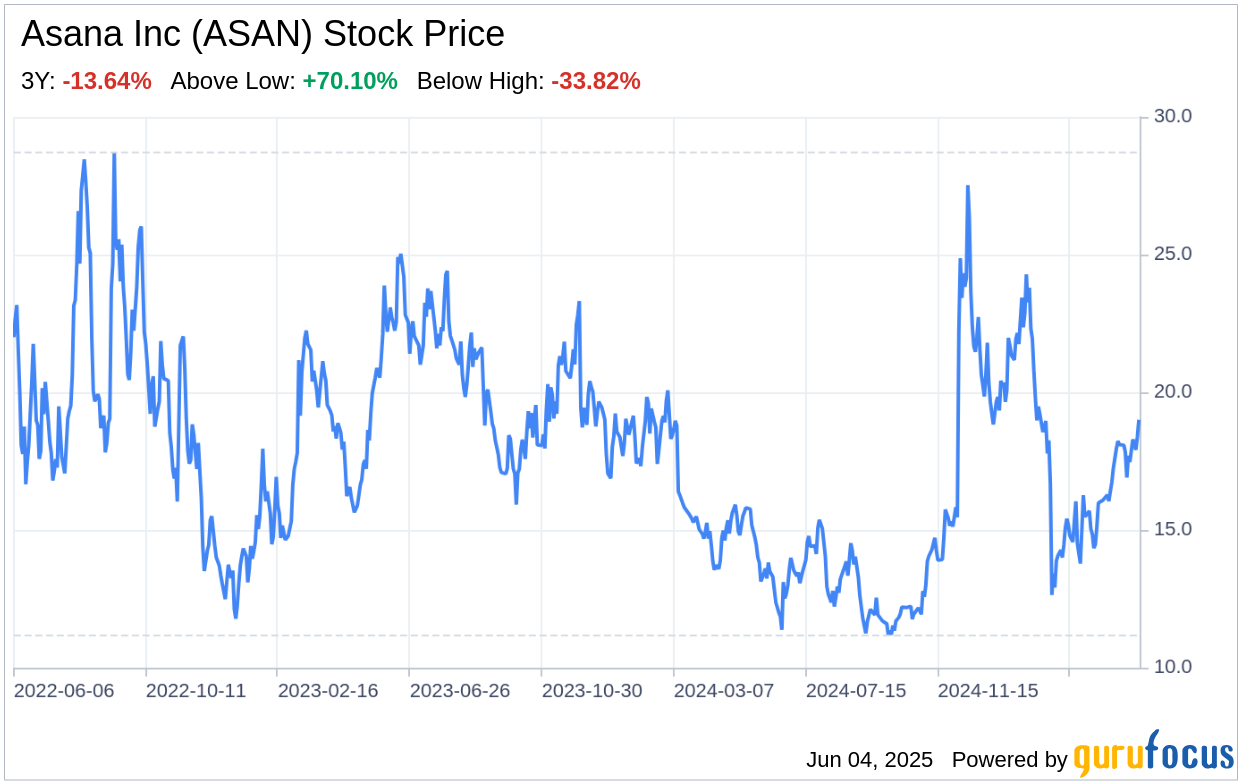Asana Inc (ASAN, Financial), a leading provider of collaborative work management software, has recently filed its 10-Q report on June 3, 2025. This SWOT analysis delves into the company's financials and strategic positioning, providing investors with a comprehensive understanding of its current state and future prospects. According to the latest filing, Asana Inc (ASAN) reported a revenue increase to $187.3 million from $172.4 million in the previous year. However, the company continues to operate at a net loss, with a reduction in net loss from $(63.7) million to $(40.0) million year-over-year. This financial overview sets the stage for a deeper examination of the company's strengths, weaknesses, opportunities, and threats.

Strengths
Revenue Growth and Market Positioning: Asana Inc (ASAN, Financial) has demonstrated a consistent increase in revenues, indicating a growing demand for its work management solutions. The company's revenue growth from $172.4 million to $187.3 million showcases its ability to attract and retain customers in a competitive market. Asana's strong market positioning is further solidified by its scalable and dynamic tools that cater to a wide range of use cases, from marketing programs to IT approvals. This strength is a testament to the company's robust business model and its appeal to organizations seeking efficient project and process management solutions.
Innovative Technology and User Experience: Asana Inc (ASAN, Financial) stands out with its user-friendly interface and innovative features that enhance collaboration and productivity. The company's investment in research and development, as evidenced by the $75.1 million expenditure, underscores its commitment to continuous innovation. Asana's platform, with its real-time visibility into projects and advanced reporting and automation capabilities, positions the company as a leader in the work management software space. This technological edge is crucial for maintaining a competitive advantage and driving user adoption.
Weaknesses
Operating at a Net Loss: Despite revenue growth, Asana Inc (ASAN, Financial) continues to report a net loss, with the latest figures showing a $(40.0) million loss. This indicates that the company is still in a phase of heavy investment in growth, which may concern investors looking for profitability. The high operating expenses, totaling $211.9 million, including significant sales and marketing costs of $99.8 million, reflect the competitive nature of customer acquisition in the SaaS industry. This weakness highlights the need for Asana to optimize its spending and improve its bottom line to achieve sustainable financial health.
Customer Conversion Challenges: Asana Inc (ASAN, Financial) faces the challenge of converting free and trial users into paying customers. The company's strategy of offering free and trial versions is designed to promote brand awareness and organic adoption. However, the effectiveness of this approach is contingent on the ability to upsell users to paid subscriptions. As the market for work management solutions becomes increasingly competitive, Asana must enhance its conversion strategies to ensure a steady flow of revenue from its user base.
Opportunities
Market Expansion and Customer Base Growth: Asana Inc (ASAN, Financial) has the opportunity to expand its market share by targeting new industries and geographic regions. The company's scalable platform is well-suited to accommodate diverse work management needs, allowing Asana to tap into untapped markets. By leveraging its strong brand and customer satisfaction, Asana can attract new users and convert them into loyal customers, fueling further revenue growth.
Leveraging AI and Technological Advancements: The integration of AI into Asana's platform presents a significant opportunity for the company to differentiate itself from competitors. By developing AI-driven features that automate complex tasks and provide predictive insights, Asana can enhance user productivity and decision-making. This technological leap could position Asana as an innovator in the work management space, attracting customers seeking cutting-edge solutions.
Threats
Intense Competition and Market Saturation: Asana Inc (ASAN, Financial) operates in a highly competitive industry where new entrants and established players continually vie for market share. The threat of competition requires Asana to continuously innovate and invest in marketing to maintain its position. Additionally, market saturation could lead to increased customer acquisition costs and pressure on pricing, potentially impacting Asana's profitability and growth.
Macroeconomic Uncertainties: Global economic conditions, such as fluctuating interest rates, financial market instability, and geopolitical tensions, pose a threat to Asana's business. These uncertainties can affect IT spending patterns and lead to cautious investment decisions by organizations, potentially reducing demand for Asana's platform. The company must navigate these challenges by adapting its strategies to ensure resilience in the face of economic fluctuations.
In conclusion, Asana Inc (ASAN, Financial) exhibits a strong market presence with its innovative work management platform, driving revenue growth despite operating at a net loss. The company's focus on technological advancements and user experience positions it well for future growth. However, Asana faces challenges in achieving profitability and converting free users to paying customers. Opportunities for expansion and AI integration present promising avenues for differentiation and increased market share. Nevertheless, threats from intense competition and macroeconomic uncertainties require strategic planning and adaptability.
This article, generated by GuruFocus, is designed to provide general insights and is not tailored financial advice. Our commentary is rooted in historical data and analyst projections, utilizing an impartial methodology, and is not intended to serve as specific investment guidance. It does not formulate a recommendation to purchase or divest any stock and does not consider individual investment objectives or financial circumstances. Our objective is to deliver long-term, fundamental data-driven analysis. Be aware that our analysis might not incorporate the most recent, price-sensitive company announcements or qualitative information. GuruFocus holds no position in the stocks mentioned herein.
